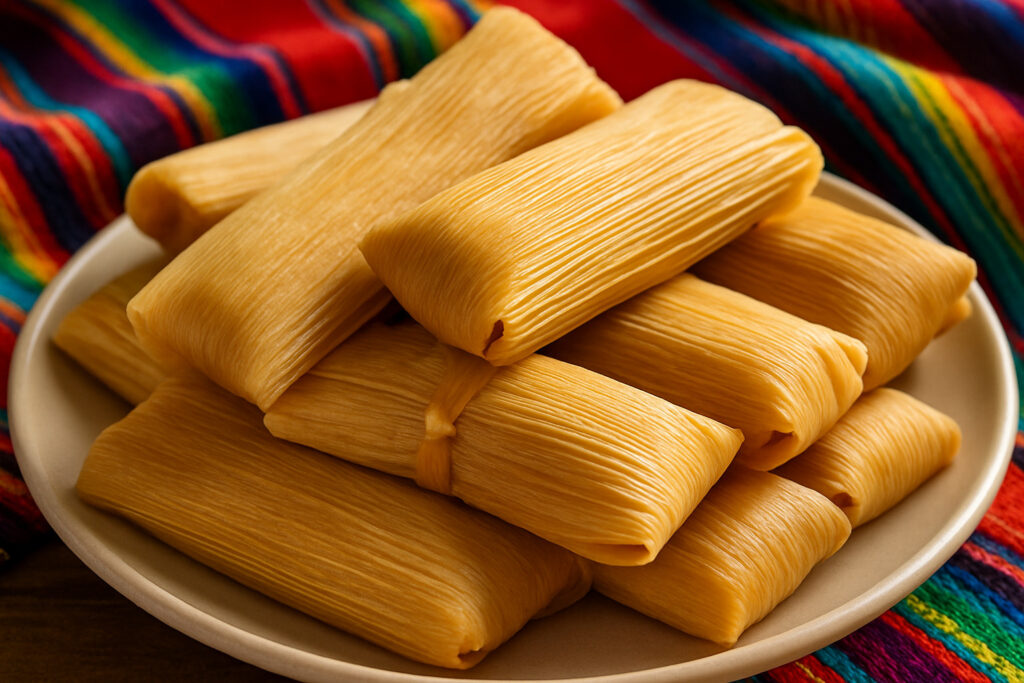Why Tamales Are the Ultimate Comfort Food Worth Mastering
Tamales are traditional Mesoamerican parcels made from corn masa (dough) filled with savory or sweet ingredients, wrapped in corn husks or banana leaves, and steamed to perfection. These ancient comfort foods have been nourishing families for over 5,000 years.
Quick Tamale Facts:
- What they are: Steamed corn dough packages with meat, cheese, or sweet fillings
- Main ingredients: Masa harina, lard or shortening, broth, fillings, corn husks
- Cooking method: Steamed upright for 1-2 hours
- Origins: Mesoamerica (8000-5000 BC)
- Calories: 246-371 per tamale depending on filling
- Storage: 1 week refrigerated, 6 months frozen
If you’re an adventurous foodie seeking authentic culinary experiences, tamales offer the perfect gateway into one of the world’s oldest cooking traditions. These portable, flavorful packages were once carried by Aztec warriors and Maya hunters as convenient battlefield rations.
Today, tamales remain central to celebrations across Latin America and beyond. The beauty of tamales lies in their simplicity and versatility. Whether you’re craving spicy pork in red chile sauce, tender chicken with salsa verde, or sweet pineapple and raisins, there’s a tamale variation for every palate.
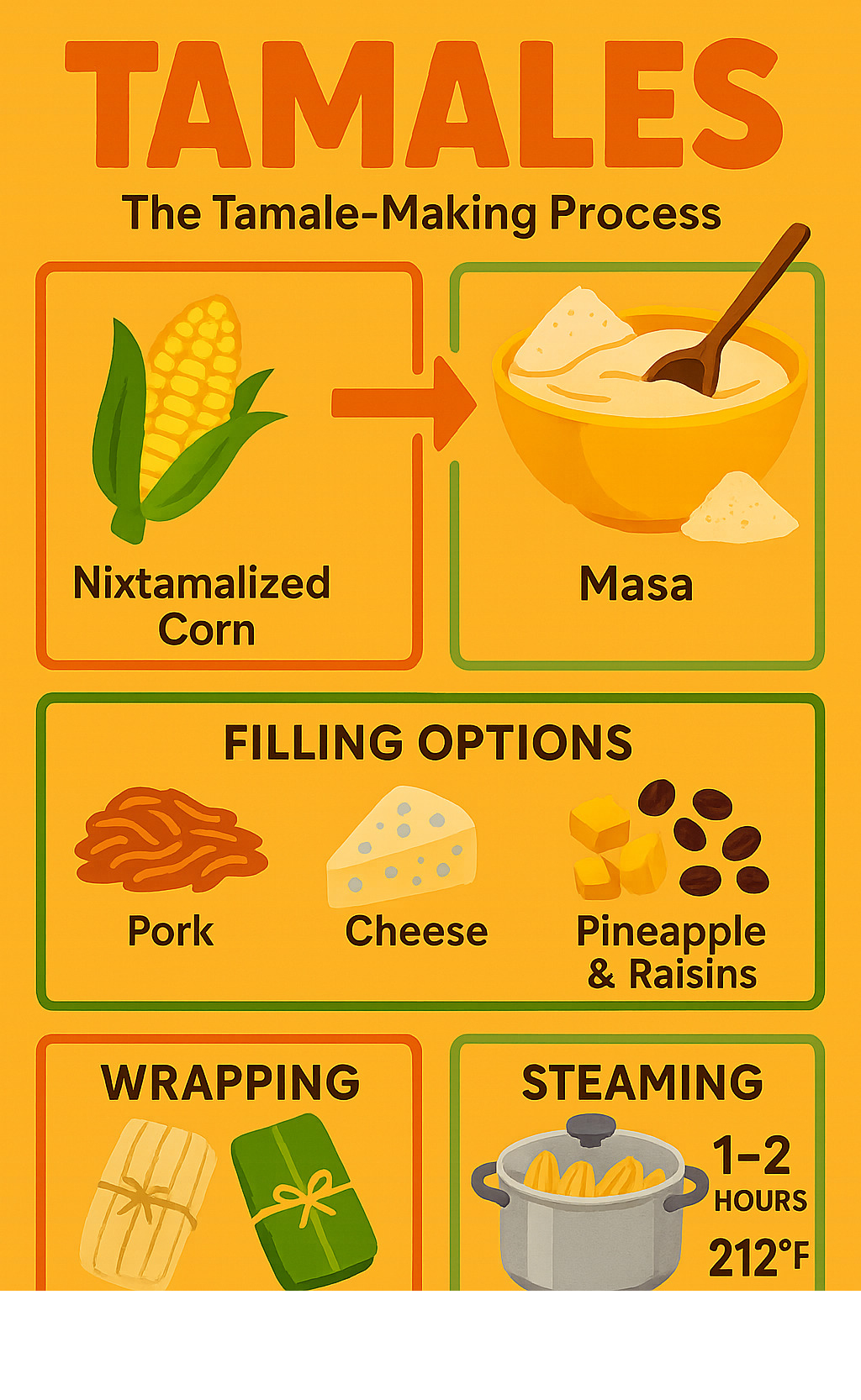
Tamales terms to learn:
Tamales 101: History & Definition
Tamales have their roots deep in Mesoamerica, dating back to 8000-5000 BC. Long before your favorite taco joint existed, ancient civilizations like the Aztecs, Maya, Olmecs, and Toltecs were already perfecting these little packages of deliciousness. Archaeological evidence shows that tamales were actually the go-to corn-based food – even more popular than tortillas back then!
The word “tamale” comes from the Nahuatl word “tamalli,” which simply means “wrapped food.” Here’s a fun fact: the English word “tamale” actually came from a mistake! Spanish speakers would say “tamales” (plural), and English speakers thought that was singular, so they created “tamale” for one.
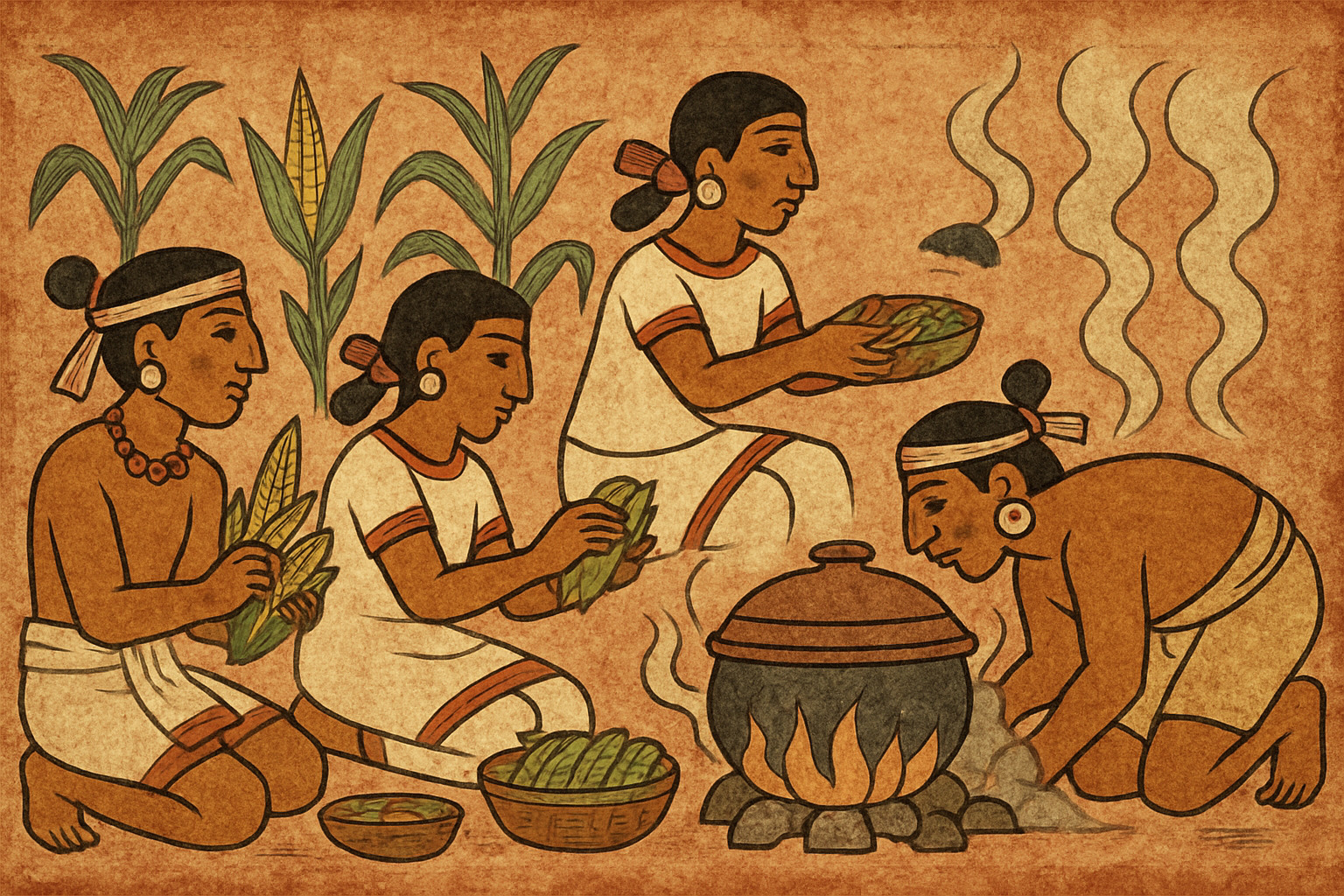
But tamales weren’t just everyday snacks – they were sacred. The Aztecs held a special ceremony called Atamalcualiztli every eight years, where they served plain tamales to “let the corn rest.” These ancient tamales were also incredibly practical. Warriors and travelers carried them as portable meals because they could be dried with wood ash to create a hard shell that lasted up to 20 days without spoiling.
The Iconic Cuisine: Tamales of the Maya offers fascinating glimpses into how these foods were both sacred and essential for survival in pre-Columbian times.
What Is a Tamale?
At its heart, a tamale is beautifully simple: corn masa (dough) wrapped around a filling and steamed in natural packaging. The masa starts with corn that’s been nixtamalized – treated with lime or ash in a process that makes the corn more nutritious and gives it that distinctive flavor we associate with authentic Mexican cuisine.
The filling can be almost anything your heart desires. Seasoned pork in red chile sauce, chicken swimming in salsa verde, beans and cheese for vegetarians, or sweet fruits for dessert tamales. Everything gets wrapped in corn husks, banana leaves, or other natural materials, then steamed until the masa becomes tender and fluffy.
Why Tamales Endure Across Millennia
Tamales have survived thousands of years because they’re brilliant in both practical and cultural ways. Nutritionally, they’re a complete meal – combining corn’s carbohydrates with protein-rich fillings. A single homemade pork tamale packs about 246-371 calories, 15-23 grams of fat, 12-13 grams of protein, and 16-29 grams of carbohydrates.
But the real magic happens in the making. Tamales create community like few other foods can. Making them is traditionally a group activity called a tamalada, where families gather and everyone has a job. This communal spirit has kept the tradition alive across generations and continues today. Whether you’re following this beginner’s guide to tamales or you’re already a seasoned pro, you’re participating in a tradition that connects you to thousands of years of culinary history.
Essential Ingredients, Dough Science & Gear
Making perfect tamales starts with understanding your ingredients and the science behind them. The foundation of any great tamale is masa harina – but not just any masa harina. You’ll want masa harina specifically labeled “for tamales,” which has a coarser grind than regular tortilla masa.
For about 40 tamales, you’ll need 6 cups of masa harina for tamales, 1 cup of lard or shortening, and 2-3 cups of warm chicken or pork broth. Don’t forget 1 teaspoon each of baking powder and salt, plus 1 large package of dried corn husks and 3-4 cups of your prepared filling.
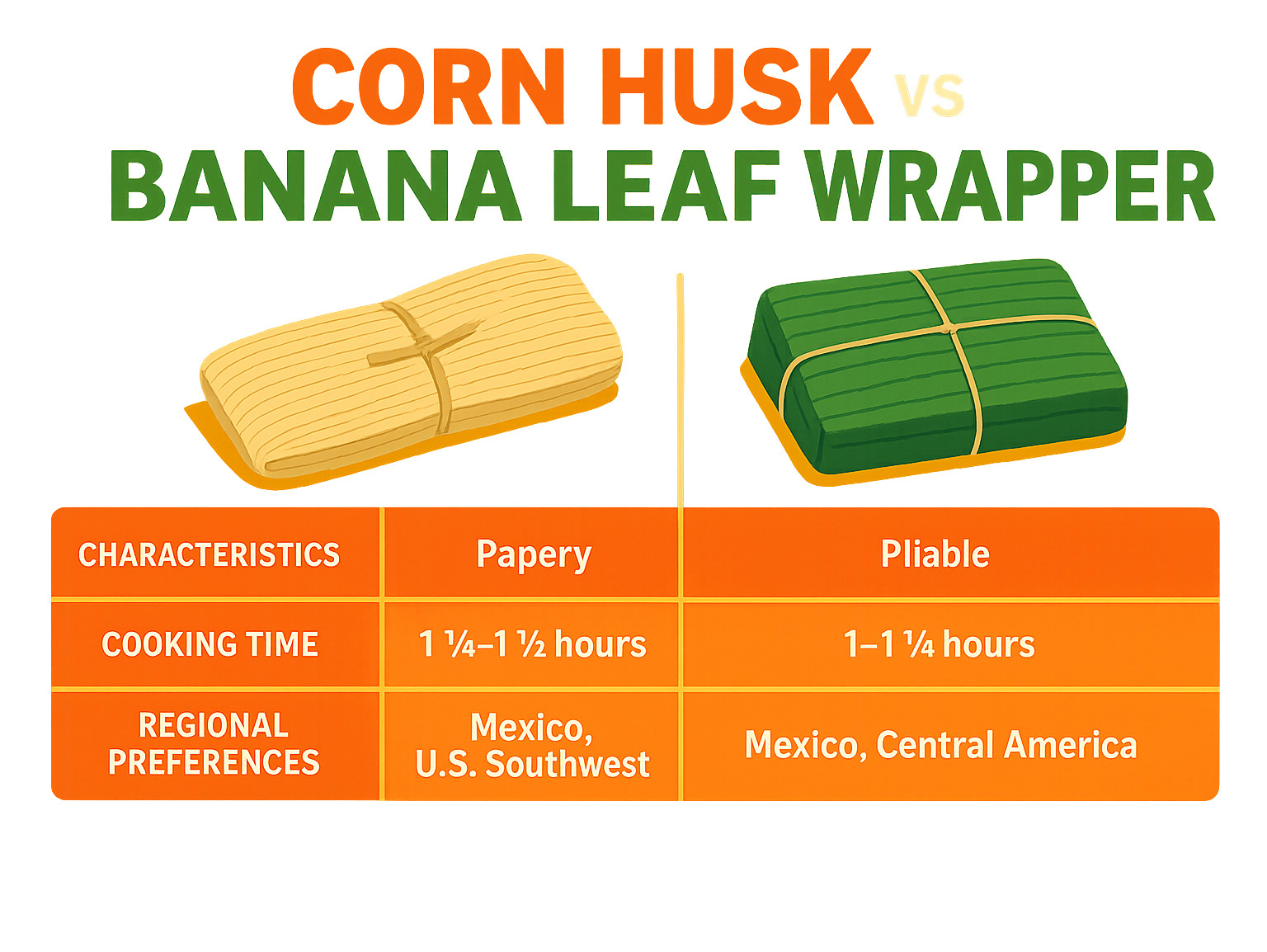
The secret to fluffy tamales lies in proper hydration and aeration. Your masa needs to be gradually hydrated with warm broth while being whipped to incorporate air. This creates a light, cake-batter consistency that transforms into tender, cloud-like tamales rather than dense, heavy ones.
Understanding Masa Harina & Lard for Perfect Tamales
Masa harina is corn that’s been through nixtamalization – a process where corn is cooked with lime or ash to remove the hull and dramatically improve its nutritional value. Getting the hydration ratio right is crucial for your beginner’s guide to tamales success. Start with about 2 cups of warm broth for 6 cups of masa harina, then add more gradually until you achieve a spreadable consistency.
Lard might sound intimidating, but it’s actually your secret weapon for incredible tamales. It acts as both a flavor carrier and texturizer, and when properly whipped with broth, it creates those tiny air pockets that make masa light and tender. If you’re hesitant about using lard, vegetable shortening works too, though you’ll sacrifice some authentic flavor.
Stocking Your Tamale Toolkit
You don’t need fancy equipment to make amazing tamales, but having the right tools makes the process much more enjoyable. A large steamer pot with a tight-fitting lid is essential – you’ll be steaming for 1-2 hours, so a good seal prevents water loss.
A stand mixer will save your arms when whipping masa, though you can certainly do it by hand. You’ll also want large bowls for soaking husks and mixing, plus an instant-read thermometer to check for doneness.
Here’s a pro tip: use the “pennies trick.” Drop a few clean pennies in your steamer water – when they stop rattling, you know the water level is getting dangerously low and it’s time to add more.
For those interested in learning more hands-on techniques from local experts, our Street Food Tours offer incredible opportunities to see traditional tamale-making in action.
Step-by-Step: How To Make Tamales at Home
Making tamales at home is like hosting a delicious orchestra – every ingredient needs to come together at just the right moment. Plan for about 3-4 hours total, but most of this time is hands-off steaming while you relax with a cup of coffee.
The secret to stress-free tamale making is thinking like a restaurant chef: prep everything first, then assemble. Set up your assembly line before you start. You’ll want one station for clean corn husks, another for your fluffy masa, one for your delicious fillings, and a final spot for your completed tamales.
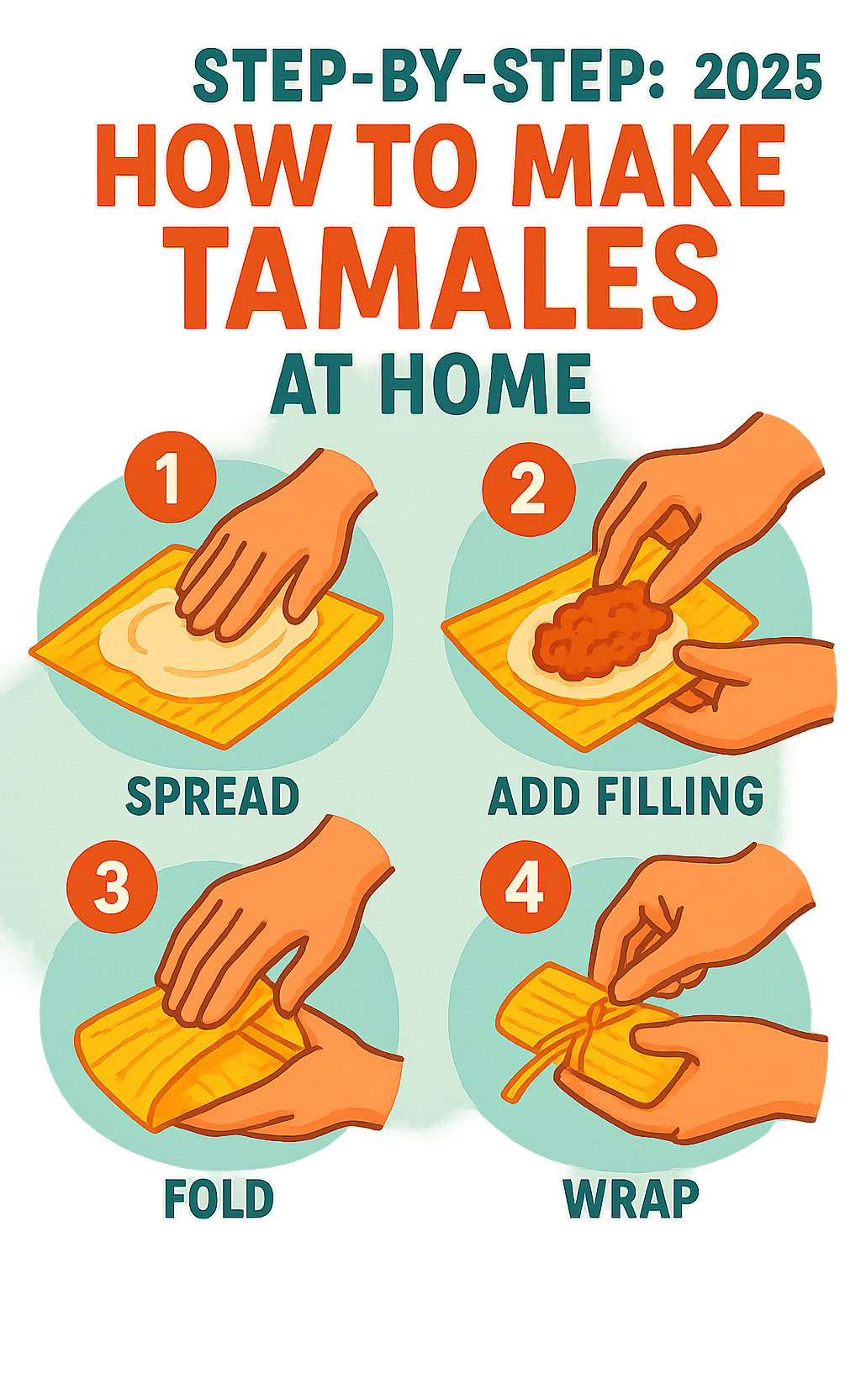
Mixing the Masa for Tamales
Perfect tamales start with perfect masa. In your stand mixer, whip 1 cup of lard or shortening with 1/2 cup of warm broth until it’s light and fluffy – about 5 minutes of mixing. This creates tiny air bubbles that will make your tamales tender instead of dense.
Gradually add 6 cups of masa harina for tamales to your fluffy fat mixture. Sprinkle in 1 teaspoon each of baking powder and salt, plus 1 teaspoon of ground cumin if you want that extra depth of flavor. While your mixer runs on low speed, slowly pour in 2-3 cups of warm chicken or pork broth until you achieve that perfect cake-batter consistency.
Filling & Folding Tamales Like a Pro
Red pork made from pork shoulder simmered in guajillo chile sauce is a classic that never disappoints. Salsa verde chicken brings bright, tangy flavors with its tomatillo-jalapeño base. For vegetarians, bean and cheese tamales are absolutely divine. And don’t forget sweet tamales – pineapple with raisins and cinnamon will surprise and delight your taste buds.
The folding technique is easier than you might think. Start with a large, pliable corn husk. Spread 2-3 tablespoons of masa in the center, leaving about an inch border on all sides. Add 1-2 tablespoons of your chosen filling right in the center of the masa. Resist the urge to overstuff!
To fold, bring the sides of the husk over the filling, overlapping them slightly. Then fold the bottom (narrow end) up toward the center. You can tie them with strips of corn husk if you want extra security.
Steaming Tamales Safely & Efficiently
Fill your steamer pot with 2-3 inches of water and place your steamer basket inside. Arrange your tamales upright with the open ends pointing up. Cover them with extra corn husks or a clean kitchen towel to keep the steam circulating evenly.
Steam for 1-2 hours, checking the water level every 30 minutes. Drop a few pennies in the steamer water before you start. When they stop rattling against the pot bottom, you know it’s time to add more water.
A perfectly cooked tamale will have masa that pulls away cleanly from the husk. For those who love modern convenience, an Instant Pot works beautifully too. Stack your tamales inside with 1 cup of water, cook on high pressure for 25 minutes, then let the pressure release naturally for 10 minutes.
Regional Variations & Global Cousins of Tamales
The world of tamales is incredibly diverse, with over 370 distinct varieties found across Mexico alone. Each region has developed its own unique take on this ancient food, creating a mix of flavors that reflects local ingredients, cultural influences, and centuries of culinary evolution.
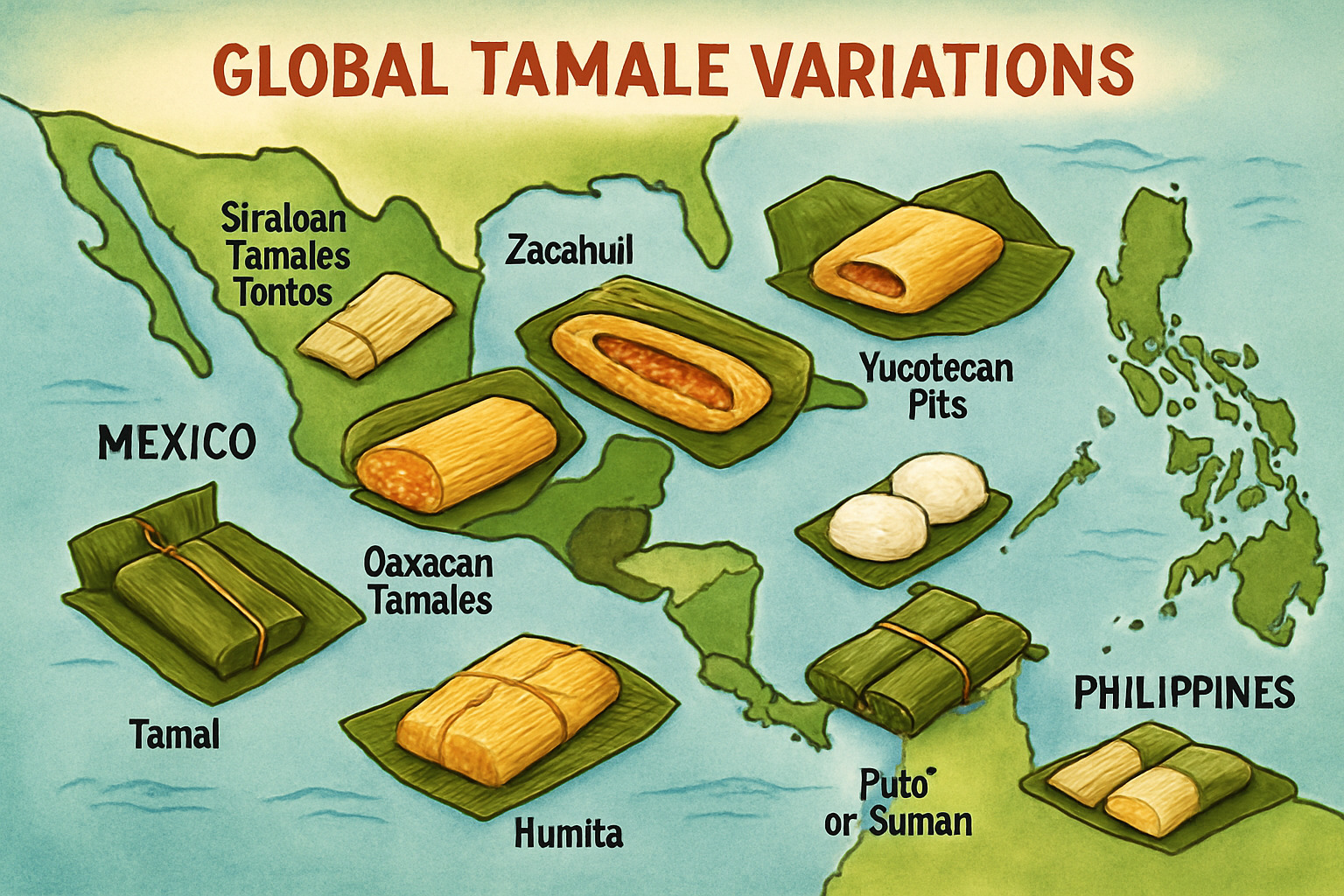
The creativity is endless. Some regions bury their tamales underground to cook them slowly over coals. Others wrap them in banana leaves for a completely different flavor profile. The world record tamale, created in Villahermosa, Tabasco, Mexico, measured an incredible 50.05 meters in length.
Spotlight: Mexican Tamales Across States
Mexico’s diverse geography and cultural heritage have created distinct tamale traditions in each state. In Oaxaca, banana leaves replace corn husks, and the fillings often feature mole negro – a complex sauce with over 20 ingredients including chocolate.
Travel to the Yucatán, and you’ll find pibs – tamales that showcase ancient Mayan influence. They’re colored with achiote (annatto), giving them a distinctive red hue and earthy flavor.
The Huasteca region takes things to the extreme with zacahuil – massive tamales that can stretch up to 5 meters long and feed 50-200 people. In Sinaloa, you’ll find the charmingly named “tamales tontos” or “silly tamales.” These contain only perfectly seasoned masa with no filling, showcasing the pure flavor of expertly prepared corn dough.
Beyond Mexico: Tamales Around the World
The concept of seasoned starch wrapped in natural packaging has appeared independently in cultures worldwide. Nicaragua’s nacatamal are substantial affairs filled with pork, rice, and vegetables. Venezuela’s hallacas are Christmas specialties that include olives and raisins.
South America offers humitas – sweet corn tamales that are often served as dessert. The Caribbean contributes pasteles, made with plantain and yautía instead of corn. Even the Mississippi Delta has its own version – hot tamales brought by Mexican railroad workers.
Brazil’s pamonha are sweet corn tamales popular at June festivals, while the Philippines offers binaki – corn tamales that reflect Spanish colonial influence adapted to local preferences.
Serving, Storing & Reheating Your Tamales
The moment you unwrap a perfectly steamed tamale, you’re participating in a ritual that’s thousands of years old. The corn husk peels away easily, revealing the fluffy masa inside. Unlike many Mexican dishes that rely on added sauces, tamales are designed to be complete meals in themselves.
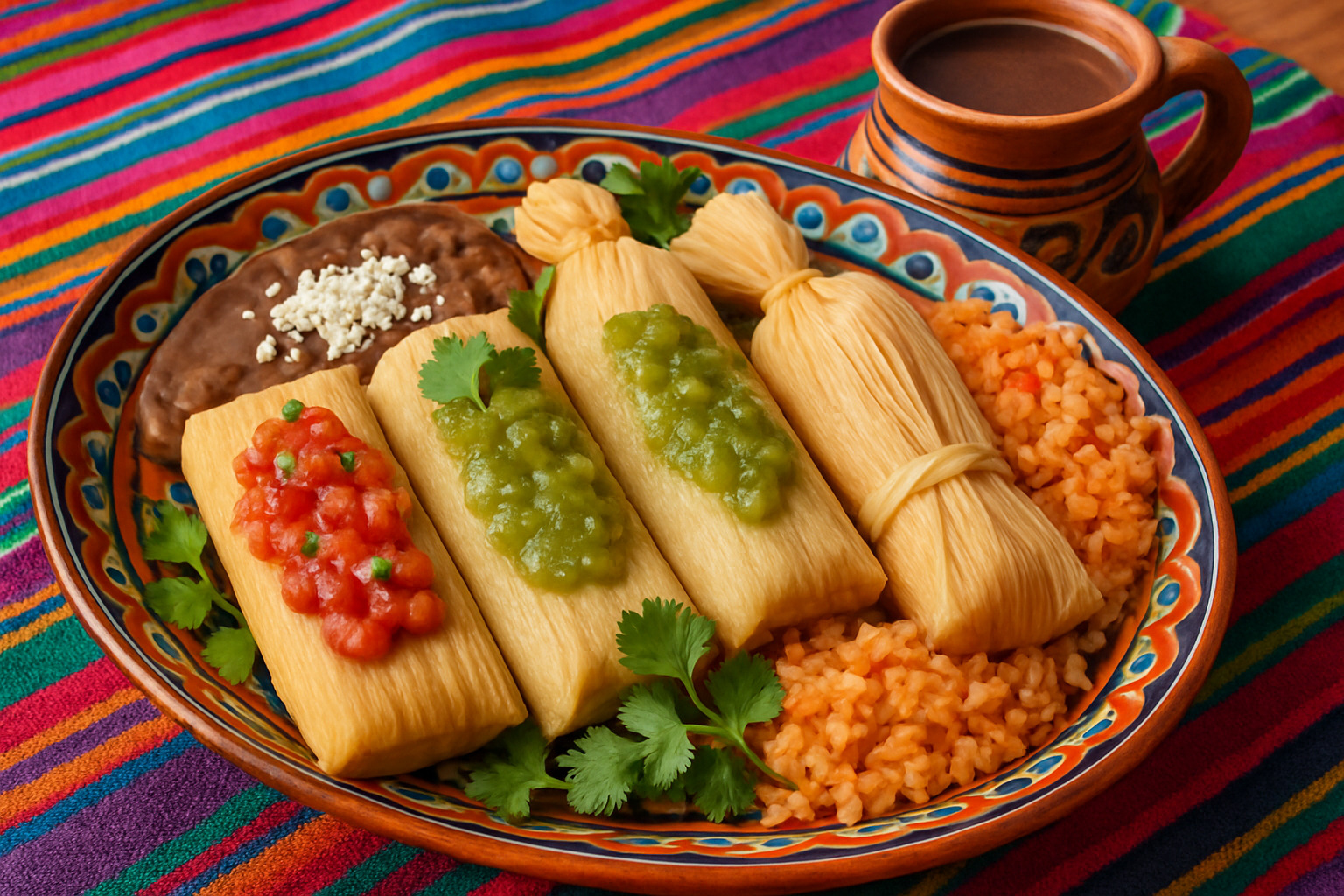
The classic pairing is champurrado – a thick, chocolate-based warm drink that perfectly balances the savory richness of most tamales. Café de olla, with its warming cinnamon notes, offers another traditional beverage option.
For sides, think simple and supporting. Refried beans provide creamy richness that doesn’t compete with the tamale’s flavors. Mexican rice adds a light, tomato-kissed element. Fresh salsa can add a fresh contrast, though many purists prefer their tamales unadorned.
The key to serving tamales is patience. Let them rest for 10-15 minutes after steaming – this makes them much easier to handle and prevents burns.
For a complete Mexican meal experience, pair your tamales with our guide to Mexican Tortas – another beloved handheld Mexican food that shares the tamale’s portable convenience.
Make-Ahead, Freeze, and Reheat Guide for Tamales
Here’s where tamales truly shine as the ultimate convenience food. Fresh tamales will stay delicious in your refrigerator for up to one week when stored in airtight containers. But the real magic happens when you freeze them. Properly frozen tamales maintain their quality for up to six months.
When freezing tamales, keep them in their husks – this natural packaging protects the masa from freezer burn. Store them upright in freezer bags if possible.
Reheating tamales is wonderfully forgiving. The best method is steaming, which takes 15-20 minutes from refrigerated and 25-30 minutes from frozen. Don’t bother thawing first – they steam beautifully straight from the freezer.
For quicker options, the microwave works well. Wrap each tamale in a damp paper towel and heat for 2-3 minutes. The oven method involves wrapping them in foil and heating at 350°F for 15-20 minutes.
The genius of making tamales is that doubling your batch requires almost the same effort as making a single batch. Since you’re already setting up the assembly line and steaming equipment, why not make enough for several weeks of meals?
Frequently Asked Questions about Tamales
Making tamales at home can feel intimidating at first, but most concerns are easily addressed with the right information. Here are the most common questions we hear from home cooks starting on their first tamale-making trip.
How long do homemade tamales last in the fridge?
Your homemade tamales will stay fresh in the refrigerator for up to one week when stored properly. The key is keeping them in airtight containers or wrapping them tightly in plastic wrap to prevent them from drying out.
Don’t worry if the masa feels firmer when cold – this is completely normal. The tamales will return to their original soft, fluffy texture when you reheat them using any of the methods we covered earlier. Many families actually prefer making large batches specifically for this reason, enjoying fresh tamales throughout the week with minimal effort.
What’s the easiest filling for beginner tamales?
If you’re new to tamale-making, start with shredded chicken in salsa verde or a simple bean and cheese mixture. These beginner-friendly fillings are incredibly forgiving and won’t leave you scrambling if something goes slightly wrong.
Chicken in salsa verde is particularly foolproof because the sauce keeps the meat moist, and the flavors are universally loved. For the bean and cheese option, use refried beans mixed with your favorite Mexican cheese blend – it’s hard to mess up, and the creamy texture spreads beautifully inside the masa.
The golden rule for beginners: avoid overly wet fillings that can make your masa soggy. Save the complex mole sauces and elaborate preparations for when you’ve mastered the basic technique. Your first batch should be about learning the folding and steaming process, not perfecting gourmet fillings.
Can I make tamales without lard for a vegan version?
Absolutely! Vegan tamales are completely achievable and delicious. Simply substitute vegetable shortening or vegan butter for the lard, and use vegetable broth instead of chicken broth in your masa preparation.
The texture will be slightly different from traditional lard-based tamales, but they’ll still be wonderfully fluffy and flavorful. Many people actually prefer the cleaner taste that comes from using vegetable shortening.
For vegan fillings, get creative with seasoned black beans, roasted vegetables, or sweet combinations featuring fruits and nuts. Mushroom-based fillings work particularly well because they provide that satisfying, meaty texture. Some of our favorite vegan combinations include black beans with roasted peppers and onions, or sweet tamales filled with pineapple, raisins, and cinnamon.
The beauty of this beginner’s guide to tamales is that once you master the basic technique, the filling possibilities become endless – whether you’re cooking for vegans, meat-lovers, or anyone in between.
Conclusion
Your journey into tamales has just begun, and what a delicious trip it promises to be! These incredible corn packages have survived over 5,000 years for good reason – they’re not just food, they’re edible stories that connect us to ancient civilizations, family traditions, and communities around the world.
When you make tamales, you’re following the same basic techniques that Aztec warriors used to prepare their portable meals. You’re participating in a tradition that has brought families together for countless generations, creating memories around kitchen tables and filling homes with the irresistible aroma of steaming corn masa.
The beauty of this beginner’s guide to tamales lies in its simplicity. Once you master the basic techniques – whipping that perfect masa, getting your filling ratios right, and nailing the folding technique – you’ll have open uped a skill that will serve you for life.
But tamales are just the beginning of your culinary exploration. The patience you develop waiting for them to steam, the technique you learn in balancing flavors, and the cultural appreciation you gain will serve you well as you explore other amazing global cuisines.
At The Dining Destination, we believe that understanding food is the fastest way to understand people. Tamales teach us about resourcefulness, community, and the magic that happens when simple ingredients are transformed through time-honored techniques.
Ready to expand your culinary horizons even further? Our Best Food Destinations guide will help you plan your next food-focused trip, whether you’re dreaming of street food tours or authentic cooking classes around the world.
From our New York City kitchen to yours, we hope your first batch of tamales brings you as much joy as they’ve brought families for millennia. The best tamales are made with patience, shared with people you love, and enjoyed with gratitude for the incredible culinary heritage wrapped in every single corn husk.
Happy tamale making, and here’s to many more delicious trips ahead!

